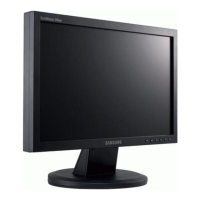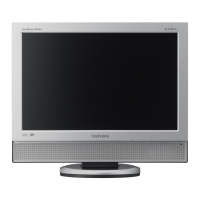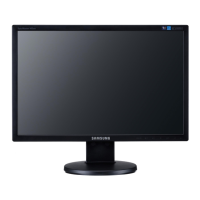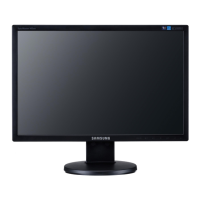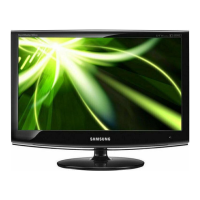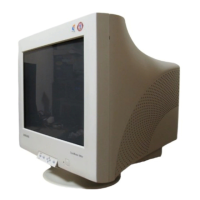Do you have a question about the Samsung SyncMaster 940BW and is the answer not in the manual?
Install necessary software for monitor functionality.
Install additional software for enhanced monitor features.
Important safety warnings and conventions.
Information on the monitor's power saving features.
Guidelines for maintaining a healthy posture while using the monitor.
Overview of features like RTA for enhanced display performance.
List of items included in the monitor package.
Guides and warranty information provided with the monitor.
Details on D-sub, DVI, and power cables.
Explanation of OSD menu access and button functions.
Identification of rear panel ports and Kensington lock slot.
Step-by-step guide for connecting the monitor to various computers.
Instructions for connecting via DVI cable.
Instructions for connecting via DVI-HDMI cable.
Steps for assembling the monitor stand or base.
Guide for automatic driver installation using the CD-ROM.
Guide for manual driver installation.
Steps for installing drivers on Windows XP, 2000, and NT.
Steps for setting up the monitor in a Linux environment.
How to install the Natural Color software for color management.
How to uninstall the Natural Color software.
Explanation of the MENU, Brightness, AUTO, and Source buttons.
How to use the AUTO button for automatic screen adjustment.
How to lock or unlock OSD settings for protection.
How to select different viewing modes with MagicBright™.
Direct control of brightness and source selection.
How to adjust screen brightness and contrast levels.
Details on MagicColor modes, MagicZone, Hue, Saturation.
Adjusting color tone, R, G, B balance, and gamma.
Reducing vertical and horizontal noise in the image.
Adjusting image sharpness and horizontal/vertical position.
Changing OSD language and menu position.
Configuring OSD background transparency and menu timeout.
Using Auto Source, Image Reset, Color Reset, and RTA functions.
Introduction to the MagicTune™ software utility.
Core capabilities of MagicTune™ for display tuning.
How MagicTune™ interacts with the monitor's OSD.
Step-by-step guide for installing MagicTune™.
Common issues encountered during MagicTune™ installation.
Hardware and OS requirements for MagicTune™.
Explains the function of OK and Reset buttons in MagicTune™.
Details on adjusting screen settings via the Picture tab.
Adjusting contrast, resolution, and MagicBright™ modes.
Adjusting color tone and understanding color definitions.
Details on MagicColor modes, MagicZone, Hue, Saturation.
Using Color Innovation and Gamma correction for image quality.
Adjusting chroma for specific colors.
Adjusting image fine, coarse, position, and sharpness.
Configuring preferences, source select, color weakness, and PIP.
Assigning custom hotkeys for MagicTune™ features.
Accessing help files and program asset details.
Step-by-step guide to calibrate monitor colors.
Saving and applying color calibration settings for multiple users.
Viewing the impact of color calibration.
Initial checks to resolve common monitor issues.
Frequently asked questions and answers for troubleshooting.
Using the monitor's built-in diagnostic tool.
Explains common warning messages shown on the screen.
Factors affecting monitor performance and placement.
Definitions of terms like Dot Pitch, Resolution, and Refresh Rate.
Advice for achieving better display quality.
Recommendations for adjusting computer resolution for optimal picture.
Warranty coverage related to image retention and burn-in.
Explanation of what image retention is and why it occurs.
Install necessary software for monitor functionality.
Install additional software for enhanced monitor features.
Important safety warnings and conventions.
Information on the monitor's power saving features.
Guidelines for maintaining a healthy posture while using the monitor.
Overview of features like RTA for enhanced display performance.
List of items included in the monitor package.
Guides and warranty information provided with the monitor.
Details on D-sub, DVI, and power cables.
Explanation of OSD menu access and button functions.
Identification of rear panel ports and Kensington lock slot.
Step-by-step guide for connecting the monitor to various computers.
Instructions for connecting via DVI cable.
Instructions for connecting via DVI-HDMI cable.
Steps for assembling the monitor stand or base.
Guide for automatic driver installation using the CD-ROM.
Guide for manual driver installation.
Steps for installing drivers on Windows XP, 2000, and NT.
Steps for setting up the monitor in a Linux environment.
How to install the Natural Color software for color management.
How to uninstall the Natural Color software.
Explanation of the MENU, Brightness, AUTO, and Source buttons.
How to use the AUTO button for automatic screen adjustment.
How to lock or unlock OSD settings for protection.
How to select different viewing modes with MagicBright™.
Direct control of brightness and source selection.
How to adjust screen brightness and contrast levels.
Details on MagicColor modes, MagicZone, Hue, Saturation.
Adjusting color tone, R, G, B balance, and gamma.
Reducing vertical and horizontal noise in the image.
Adjusting image sharpness and horizontal/vertical position.
Changing OSD language and menu position.
Configuring OSD background transparency and menu timeout.
Using Auto Source, Image Reset, Color Reset, and RTA functions.
Introduction to the MagicTune™ software utility.
Core capabilities of MagicTune™ for display tuning.
How MagicTune™ interacts with the monitor's OSD.
Step-by-step guide for installing MagicTune™.
Common issues encountered during MagicTune™ installation.
Hardware and OS requirements for MagicTune™.
Explains the function of OK and Reset buttons in MagicTune™.
Details on adjusting screen settings via the Picture tab.
Adjusting contrast, resolution, and MagicBright™ modes.
Adjusting color tone and understanding color definitions.
Details on MagicColor modes, MagicZone, Hue, Saturation.
Using Color Innovation and Gamma correction for image quality.
Adjusting chroma for specific colors.
Adjusting image fine, coarse, position, and sharpness.
Configuring preferences, source select, color weakness, and PIP.
Assigning custom hotkeys for MagicTune™ features.
Accessing help files and program asset details.
Step-by-step guide to calibrate monitor colors.
Saving and applying color calibration settings for multiple users.
Viewing the impact of color calibration.
Initial checks to resolve common monitor issues.
Frequently asked questions and answers for troubleshooting.
Using the monitor's built-in diagnostic tool.
Explains common warning messages shown on the screen.
Factors affecting monitor performance and placement.
Definitions of terms like Dot Pitch, Resolution, and Refresh Rate.
Advice for achieving better display quality.
Recommendations for adjusting computer resolution for optimal picture.
Warranty coverage related to image retention and burn-in.
Explanation of what image retention is and why it occurs.
| Display | LCD |
|---|---|
| Pixel pitch | 0.285 x 0.285 mm |
| Display diagonal | 19 \ |
| Separate H/V sync | Yes |
| Display resolution | 1440 x 900 pixels |
| Vertical scan range | 56 - 75 Hz |
| Horizontal scan range | 30 - 81 kHz |
| Contrast ratio (typical) | 500:1 |
| Display number of colors | 16.78 million colors |
| Viewing angle, horizontal | 160 ° |
| Display brightness (typical) | 300 cd/m² |
| Panel mounting interface | 75 x 75 mm |
| USB Type-A downstream ports quantity | 0 |
| Power consumption (standby) | 1 W |
| Power consumption (typical) | 42 W |
| Package weight | 5600 g |
| Certification | TCO'03 |
| Market positioning | - |
| Depth (with stand) | 200 mm |
|---|---|
| Height (with stand) | 360.7 mm |
| Depth (without stand) | 65.4 mm |
| Width (without stand) | 439 mm |
| Height (without stand) | 289 mm |

